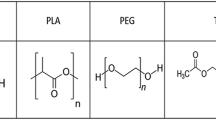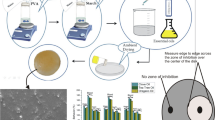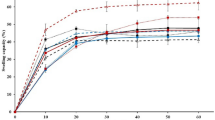Abstract
The aim of the present study was to develop PVA/PEO/CMC/aloe vera (PPCAV) and PVA/PEO/CMC/curcumin (PPCCu) dressings with nonwoven polyester fabric as the support layer via freeze-drying (FD) approach. Tetracycline hydrochloride drug (TC) was loaded along with curcumin and aloe vera on these dressings. The morphology of the dressings was characterized by scanning electron microscopy. The swelling behavior, water vapor transmission rate (WVTR), in vitro drug release and antimicrobial nature were analyzed to assess the applicability of these freeze-dried membranes as wound dressing materials. The results show that these dressings made from PPCAVTC and PPCCuTC were highly porous with three-dimensional interconnected porous morphology. The cumulative release of drug from the dressings increases with increasing immersion time and continued up to 24 h, after that it gets leveled off. These dressings evidenced wonderful antimicrobial nature in vitro. These dressings were found to have more than 900 % PBS uptake, WVTR was found to be in the range 2,000–2,500 gm−2 day−1. These dressings possess many characteristics desirable in an ideal wound dressing material.
















Similar content being viewed by others
References
Gupta B, Agarwal R, Alam MS. Textile-based smart wound dressings. Ind J Fibre Text Res. 2010;35:174–87.
Winter GD. Formation of the scab and the rate of epithelization of superficial wounds in the skin of the young domestic pig. Nature. 1962;193:293–4.
Hoffman AS. Hydrogels for biomedical applications. Adv Drug Deliv Rev. 2002;43:3–12.
Kietzmann M, Braun M. Effects of the zinc oxide and cod liver oil containing ointment Zincojecol in an animal model of wound healing. Dtsch Tierarztl Wochenschr. 2006;113:331–4.
Defail AJ, Edington HD, Matthews S, Lee WC, Marra KG. Controlled release of bioactive doxorubicin from microspheres embedded within gelatin scaffolds. J Biomed Mater Res A. 2006;79:954–62.
Maeda M, Kadota K, Kajihara M, Sano A, Fujioka K. Sustained release of human growth hormone (HGH) from collagen film and evaluation of effect on wound healing in db/db mice. J Control Release. 2001;77:261–72.
Aoyagi S, Onishi H, Machida Y. Novel chitosan wound dressing loaded with minocycline for the treatment of severe burn wounds. Int J Pharm. 2007;330:138–45.
Mi FL, Wu YB, Shyu SS, Schoung JY, Huang YB, Tsai YH, Hao JY. Control of wound infections using a bilayer chitosan wound dressing with sustainable antibiotic delivery. J Biomed Mater Res. 2002;59:438–49.
Hwang MR, Kim JO, Lee JH, Kim YI, Kim JH, Chang SW, Jin SG, Kim JA, Lyoo WS, Han SS, Ku SK, Yong CS, Choi HG. Gentamicin-loaded wound dressing with polyvinyl alcohol/dextran hydrogel: gel characterization and in vivo healing evaluation. AAPS PharmSciTech. 2010;11:1092–103.
Sung JH, Hwang MR, Kim JO, Lee JH, Kim YI, Kim JH, Chang SW, Jin SG, Kim JA, Lyoo WS, Han SS, Ku SK, Yong CS, Choi HG. Gel characterisation and in vivo evaluation of minocycline-loaded wound dressing with enhanced wound healing using polyvinyl alcohol and chitosan. Int J Pharm. 2010;392:232–40.
Singh B, Pal L. Development of sterculia gum based wound dressings for use in drug delivery. Eur Polym J. 2008;44:3222–30.
Boateng JS, Pawar HV, Tetteh J. Polyox and carrageenan based composite film dressing containing anti-microbial and anti-inflammatory drugs for effective wound healing. Int J Pharm. 2013;441:181–91.
Chopra I, Roberts M. Tetracycline antibiotics: mode of action, applications, molecular biology, and epidemiology of bacterial resistance. Microbiol Mol Biol Rev. 2001;65:232–60.
Bajpai AK, Mishra A. Preparation and characterization of tetracycline-loaded interpenetrating polymer networks of carboxymethyl cellulose and poly(acrylic acid): water sorption and drug release study. Polym Int. 2005;54:1347–56.
Zahedi P, Karami Z, Rezaeian I, Jafari SH, Mahdaviani P, Abdolghaffari AH, Abdollahi M. Preparation and performance evaluation of tetracycline hydrochloride loaded wound dressing mats based on electrospun nanofibrous poly(lactic acid)/poly(ɛ-caprolactone) blends. J Appl Polym Sci. 2012;124:4174–83.
Gupta B, Mishra S, Saxena S. Preparation of thermosensitive membranes by radiation grafting of acrylic acid/N-isopropyl acrylamide binary mixture on PET fabric. Radiat Phys Chem. 2008;77:553–60.
Gupta B, Jain R, Singh H. Preparation of antimicrobial sutures by preirradiation grafting onto polypropylene monofilament. Polym Adv Technol. 2008;19:1698–703.
Saxena S, Ray AR, Kapil A, Pavon-Djavid G, Letourneur D, Gupta B, Meddahi-Pellé A. Development of a new polypropylene-based suture: plasma grafting, surface treatment, characterization, and biocompatibility studies. Macromol Biosci. 2011;11:373–82.
el Kenawy R, Bowlin GL, Mansfield K, Layman J, Simpson DG, Sanders EH, Wnek GE. Release of tetracycline hydrochloride from electrospun poly(ethylene-co-vinylacetate), poly(lactic acid), and a blend. J Control Release. 2002;81:57–64.
Kumar TRS, Bai MV, Krishnan LK. A freeze-dried fibrin disc as a biodegradable drug release matrix. Biologicals. 2004;32:49–55.
Risbud MV, Hardikar AA, Bhat SV, Bhonde RR. Ph sensitive freeze-dried chitosan-polyvinyl pyrrolidone hydrogels as controlled release system for antibiotic delivery. J Control Release. 2000;68:23–30.
Gupta B, Agarwal R, Alam MS. Preparation and characterization of polyvinyl alcohol-polyethylene oxide-carboxymethyl cellulose blend membranes. J Appl Polym Sci. 2013;127:1301–8.
Mishra A, Chaudhary N. Study of povidone-iodine loaded hydrogels as wound dressing material. Trends Biomater Artif Organs. 2010;23:122–8.
Subramanian S, Kumar DS, Arulselvan P. Wound healing potential of aloe vera leaf gel studied in experimental rabbits. Asian J Biochem. 2006;1:178–85.
Hamman JH. Composition and applications of aloe vera leaf gel. Molecules. 2008;13:1599–616.
Vimala K, Mohan YM, Varaprasad K, Redd NN, Ravindra S, Naidu NS, Raju KM. Fabrication of curcumin encapsulated Chitosan–PVA silver nanocomposite films for improved antimicrobial activity. J Biomater Nanobiotechnol. 2011;2:55–64.
Goel A, Kunnumakkara AB, Aggarwal BB. Curcumin as “Curecumin”: from kitchen to clinic. Biochem Pharmacol. 2008;75:787–809.
Maheshwari RK, Singh AK, Gaddipati J, Srimal RC. Multiple biological activities of curcumin: a short review. Life Sci. 2006;78:2081–7.
Suwantong O, Opanasopit P, Ruktanonchai U, Supaphol P. Electrospun cellulose acetate fiber mats containing curcumin and release characteristic of the herbal substance. Polymer. 2007;48:7546–57.
Shah CP, Mishra B, Kumar M, Priyadarsini KI, Bajaj PN. Binding studies of curcumin to polyvinyl alcohol/polyvinyl alcohol hydrogel and its delivery to liposomes. Curr Sci. 2008;95:1426–32.
Mohanty C, Sahoo SK. The in vitro stability and in vivo pharmacokinetics of curcumin prepared as an aqueous nanoparticulate formulation. Biomaterials. 2010;31:6597–611.
Gupta B, Agarwal R, Alam MS. Aloe vera loaded poly(vinyl alcohol)–poly(ethylene oxide)-carboxymethyl cellulose-polyester nonwoven membranes. J Biomater Tissue Eng. 2013;3:503–11.
Agarwal R, Alam MS, Gupta B. Preparation of curcumin loaded poly(vinyl alcohol)-poly(ethylene oxide)-carboxymethyl cellulose membranes for wound care application. J Biomater Tissue Eng. 2013;3:273–83.
Agarwal R, Alam MS, Gupta B. Polyvinyl alcohol-polyethylene oxide-carboxymethyl cellulose membranes for drug delivery. J Appl Polym Sci. 2013;129:3728–36.
Queen D, Gaylor JDS, Evans JH, Courtney JM, Reid WH. The preclinical evaluation of the water vapour transmission rate through burn wound dressings. Biomaterials. 1987;8:367–71.
Author information
Authors and Affiliations
Corresponding author
Rights and permissions
About this article
Cite this article
Gupta, B., Agarwal, R. & Sarwar Alam, M. Antimicrobial and release study of drug loaded PVA/PEO/CMC wound dressings. J Mater Sci: Mater Med 25, 1613–1622 (2014). https://doi.org/10.1007/s10856-014-5184-6
Received:
Accepted:
Published:
Issue Date:
DOI: https://doi.org/10.1007/s10856-014-5184-6




